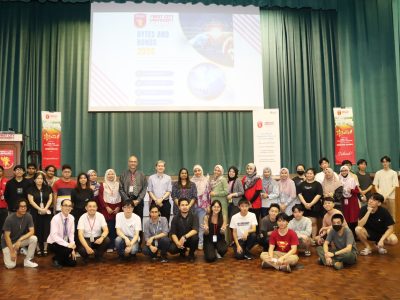Study a Graphic Design Degree in Malaysia That Goes Beyond Visuals


Imagine stepping into a space where every colour, texture, and visual element works harmoniously to tell a story—not just on paper or screen, but all around you. This is the power of a graphic design degree that goes beyond traditional boundaries. At First City University College, the Bachelor of Arts (Hons) in Graphic Design (R2/0211/6/0039)(MQA/FA6545)09/30) prepares you to shape immersive experiences that connect people and environments on a deeper level.
If you’re considering pursuing a graphic design degree in Malaysia, you may wonder how it differs from the usual digital or print design courses. The answer lies in the evolving nature of design itself. Today, graphic design graduates are no longer confined to two-dimensional media—they are creators of moodscapes, architects of atmosphere, and pioneers of spatial storytelling. This is especially relevant in Malaysia’s creative industry, where innovation and cross-disciplinary skills are increasingly prized.
Why Choose a Malaysian Graphic Design Degree?
Choosing to study a graphic design degree in Malaysia gives you access to an education that blends creativity, culture, and cutting-edge technology. Malaysia’s creative educational scene is rich with diversity and constantly evolving, offering opportunities to learn across digital, print, and spatial mediums.
Furthermore, studying in Malaysia provides practical benefits: affordable tuition fees, access to industry collaborations, and opportunities to engage in real-world projects that build portfolio. As a student, you gain hands-on experience in translating conceptual ideas into tangible outputs, preparing you for a versatile career path.
Go from Moodboards to Moodscapes
Most people associate graphic design with logos, brochures, websites, or social media visuals. While these remain important, the scope of a graphic design degree in Malaysia has broadened dramatically. A strong graphic design degree helps you to tell stories through space, colour, and composition. You’ll learn how to transform conceptual ideas (moodboards) into real-world environments (moodscapes) that enhance spaces and elevate user experiences.
This shift is crucial because Malaysian businesses and cultural institutions are recognising the value of experiential design. From retail stores and exhibitions to corporate offices and public installations, well-crafted visual environments influence how people feel, interact, and remember. Graduates equipped with this mindset can contribute not only in graphic studios but also in interior design firms, advertising agencies, and event management companies.
Cross-Disciplinary Skills that Set You Apart
One defining feature of a forward-thinking graphic design degree in Malaysia is its integration with other design disciplines, particularly interior and spatial design. This is not accidental; the lines between visual communication and physical space are blurring. Designing for a brand now involves creating consistent visual narratives across all touchpoints, including the built environment.
By learning to think in 3D and understand spatial dynamics, you can craft graphics that resonate beyond screens—signages that complement architecture, wayfinding systems that improve user flow, or immersive brand experiences that engage senses. These cross-disciplinary skills connect graphic design with interior and spatial design, opening opportunities in creative agencies, advertising, and even architecture firms.
Emerging Trends Shaping Graphic Design Education in Malaysia
Innovation is at the heart of Malaysia’s design education. New technologies like augmented reality (AR), virtual reality (VR), and interactive installations are being integrated into curriculum, providing exciting opportunities to experiment and push creative boundaries. A graphic design degree in Malaysia that embraces these tools equips you to meet future demands where interactivity and immersion are increasingly important.
Sustainability is another critical focus. Designers are encouraged to consider the environmental impact of their work, from choosing eco-friendly materials to designing with circular economy principles in mind. This ethos not only benefits the planet but also appeals to a socially conscious generation of clients and consumers who prioritise innovation and impact.
What to Expect from Your Graphic Design Degree Journey
Enrolling in a graphic design degree in Malaysia means embarking on a journey that challenges your creativity, critical thinking, and technical skills. You will learn fundamentals like typography, colour theory, and digital tools, but also develop soft skills such as collaboration, project management, and client communication.
Expect studio-based learning, critiques, and real-world challenges that push your design thinking. Internships and industry partnerships also bridge the gap between academic learning and career readiness. By the time you graduate, you will have a well-rounded portfolio that reflects your unique creative voice and be ready to impress employers.
Why First City University College Stands Out
If you’re serious about taking your passion for graphic design to the next level, choosing the right institution is important. Explore the Bachelor of Arts (Hons) in Graphic Design (R2/0211/6/0039)(MQA/FA6545)09/30) at First City University College — a programme renowned for integrating spatial and visual design.
Students benefit from lecturers with industry experience, modern design studios, and an industry-relevant curriculum designed to nurture creativity and technical expertise. With strong links to Malaysia’s creative industries, you’ll gain valuable real-world exposure through internships, networking, and collaborative projects, positioning you for success in a dynamic job market.
If you’re searching for a graphic design degree in Malaysia that goes beyond teaching you how to create images and prepares you to shape immersive brand and spatial experiences, First City University College is the place to begin. Take the first step toward shaping your future in graphic design and spatial storytelling with a university college that knows how to turn moodboards into moodscapes.







